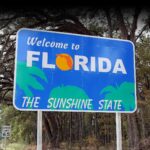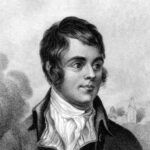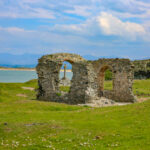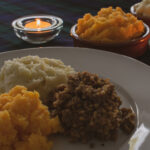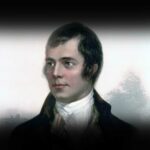Robert Burns was born on January 25, 1759, in Alloway, Ayrshire, Scotland, popularly known as the “ploughman poet” or Scotland’s national bard. He is well known for works including “To a Mouse,” “Address to a Haggis,” “Tam o’ Shanter,” “A Red, Red Rose,” and “Auld Lang Syne.” Burns’ art is distinguished by intense passion and technical proficiency. His finest work is in Scots, the southern Scottish language. He was also well-known for his amours and his disdain for traditional faith and values. He is regarded as being one of the best writers in that language over the previous four centuries. Many Scots commemorate his life and work on Burns Night, January 25, the anniversary of the poet’s works. Let us have a look at his contribution and celebrate this special day!
Fast Facts
Full Name:
Robert Burns
Nickname:
Rabbie
Birth date:
January 25, 1759
Death date:
July 21, 1796
Age:
37 years, 5 months
Zodiac Sign:
Aquarius
Background
Robert Burns was born to a diligent peasant family on January 25, 1759, in Alloway, Ayrshire, Scotland. When he was 12 years old, he started helping his father with agricultural tasks. His health was later crippled as a result of labor’s difficulty. Although Burns’ official education was minimal, he greatly enjoyed reading and was tutored by John Murdoch, who extensively educated him in 18th-century English literature, for a while. The family put a lot of effort into the Ayrshire farm and other farms, but life was never simple for them. Ongoing conflicts with landowners and their representatives fueled Burns’ rebellion against authority, which later became a central aspect of his poetry. His father passed away in 1784, and the family relocated to Mossgiel, Scotland. The charming and beautiful Burns developed multiple love connections in Mossgiel and the neighboring town of Mauchline, Scotland, some of which lasted until around 1790. His life had been never easy, with his family working tirelessly on the Ayrshire farm and other farms. Even though he continued to work on the farm in Mossgiel, Burns began composing poems, and his abilities blossomed spectacularly. Many of his writings emphasized his love of the land and its people while also making a mockery of his favorite target, the Calvinists. In 1786, he released Poems, Primarily in the Scottish Language, in neighboring Kilmarnock, Scotland, and the work was a hit. Burns was 27 years old at the time, but he had already produced some of the most brilliant and piercing works of satire (mockery or disdain) in English history. “Holy Willie’s Prayer” and “The Holy Fair” were two of their parody and derision compositions. Among the well-known compositions are “The Cotter’s Saturday Night,” “The Jolly Beggars,” the masterful “Address to the Deil,” “Address to the Unco Guid,” and “To a Mouse.” These and many more poems by Burns are perhaps unparalleled in their combination of true native dialect and depth of sentiment. Such exquisite poetry hasn’t been written in Scots for years.However, 1786 was another difficult year for Burns. His romance with Jean Armour had culminated in the arrival of twins, and her family forbade the pair from marrying because of Burns’ image as a religious critic. In addition, Burns was completely in love with Mary Campbell, for whom he wrote the ballad “Highland Mary,” but she passed away after having given birth to his child in 1786. Burns pondered fleeing the nation for Jamaica, but he changed his mind and stayed the winter in Edinburgh, Scotland, where he was recognized and celebrated for his book’s popularity. Following his marriage, Burns focused his attention on providing for his family. He leased property at Ellisland, Scotland, in 1788. After a few difficult years of trying to earn a living from his property, he relocated with Jean and his family to Dumfries, Scotland, where he began working as a tax inspector, a job he managed to hold until his demise. In his leisure time, he also composed a lot of songs. Though he produced songs before, he never published them; in the 1780s, he was able to publish and polish his lyrics, and he continued to contribute similar work until his death. His masterwork, “Tam o’Shanter,” was an extraordinary piece of narrative poetry. His neighbors and coworkers looked up to him. His illness, which had always been a concern for him, began to deteriorate, and he died of heart illness on July 21, 1796.
Career timeline
His debut ballad, "Handsome Nell," is inspired by his crush on her.
He moves to Kirkoswald to continue his studies, where he meets Peggy Thompson, a 13-year-old girl who influences him to create two songs.
In hopes of greater prosperity, Burns begins working on the farm, laboring hard to help his father.
He moves to Irvine to train as a flax-dresser after working with the Glasgow Vennel's hurling team for nine months when he eventually meets Richard Brown, who has a major impact on him.
He toils as a tax inspector until his death, and in his spare time, he composes several masterpieces that are carved in the history of Scottish ancestry for decades.
Robert Burns FAQs
How many siblings did Burns have?
Burns had six siblings. He was the eldest of seven children born to William and Agnes.
How many legitimate children did Burns have?
It is said that Burns’ had 18 offspring, of which nine were with Armour.
How many poems did Burns write in total?
He wrote 550 poems
5 Surprising Facts
-
Ploughman's backstory
Because of his farming background, Burns was termed the Ploughman Poet.
-
Love like Burns
Inspired by his love interests and relationships, he has composed and written romantic songs and poems.
-
Burns' night
Scottish folks celebrate Burns' birthday as a mark of greatness, and it has become a traditional event in which they eat Burns' Supper on his birthday!
-
Truly an unfortunate demise
Burns' son was born the same day as his father's cremation, which was truly an unfortunate occasion.
-
He was a thoughtful person
He penned his poetry largely in Scottish dialect, and very seldom in English, so that both rich and poor people may enjoy his work!
Why We Love Robert Burns
-
He was the bard of Ayrshire
He was Scotland's finest poet and, without a doubt, Scotland's best songwriter. He presents to the audience both the romantic and contemporary picture of his country in both of these areas.
-
He had an amazing ascension
The most astonishing thing about Burns is how, despite the extremely class-ridden and restrictive religious background of Scotland of his day, he rose beyond these institutionally enforced societal restraints to dwell on daily, mankind, and woman's difficulties. We have to admire this!
-
He’s an inspiration to this day
The bard of Ayrshire was an inspiration to many American literary and musical luminaries, including Abraham Lincoln, John Steinbeck, J.D. Salinger, and Bob Dylan. And he continues to be an inspiration to the people of Scotland.
Robert Burns’s birthday dates
| Year | Date | Day |
|---|---|---|
| 2023 | January 25 | Wednesday |
| 2024 | January 25 | Thursday |
| 2025 | January 25 | Saturday |
| 2026 | January 25 | Sunday |
| 2027 | January 25 | Monday |


